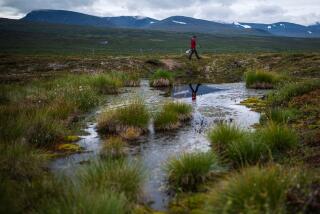Arctic’s Biggest Ice Shelf, a Sentinel of Climate Change, Cracks Apart
- Share via
The largest ice shelf in the Arctic — an 80-foot-thick slab of ice nearly the size of Lake Tahoe — has broken up, providing more evidence that the Earth’s polar regions are responding to ongoing and accelerating rates of climatic change, researchers reported Monday.
The Ward Hunt ice shelf, located 500 miles from the North Pole on the edge of Canada’s Ellesmere Island, has broken into two main parts and a series of ice islands. A massive freshwater lake long held back by the ice has drained away.
“Large blocks of ice are moving out. It’s really a breakup,” said Warwick Vincent, a professor of biology at Laval University in Quebec and co-author of the report, which will be published in an upcoming issue of the journal Geophysical Review Letters. “We’d been measuring incremental changes each year. Suddenly in one year, everything changed.”
While far larger shelves of ice have cracked off the edges of Antarctica, this is the largest ice separation in the Arctic, occurring in an area of the eastern Arctic long thought to be more protected against the gradual warming of the planet.
“This type of catastrophic [event] is quite unprecedented,” said Martin Jeffries, a professor of geophysics at the University of Alaska Fairbanks and co-author of the report.
Because of their longevity and sensitivity to temperature, ice shelves are considered “sentinels of climate change.” In recent years, scientists have seen ice shelves the size of Rhode Island break off of western Antarctica as it warms and have measured glaciers’ retreat in response to warmer temperatures throughout the western Arctic.
Weather data recorded at the nearby military station Alert on Ellesmere Island show that temperatures there have been warming since 1967 at the same rate as in western Antarctica: about one degree Fahrenheit per decade. The average July temperature of recent years of 34 degrees was above the temperature — 32 degrees — at which ice shelves are known to break up.
The researchers said they considered the weakening of the ice additional evidence of climate change in the high Arctic and said the report fit with studies that show global warming trends are connected to the human production of greenhouse gases. Those trends have been seen first and amplified in the Arctic.
But they said other factors, including ocean circulation and atmospheric patterns that can last for decades, could be contributing to the changes in the ice.
“The picture is a little murky,” Jeffries said.
Jeffries, who has worked on the region’s ice sheets for two decades, said the ice appears to have thinned dramatically in that time. The Ward Hunt ice shelf was measured at 150 feet thick in 1980 and now appears to be less than half that in some places.
The ice shelf has lost 90% of its area since 1907, when explorer Robert E. Peary crossed it on his way to the North Pole and complained bitterly about its undulating terrain.
Researchers were lucky to catch the breakup in such a remote and relatively unstudied area. Derek Mueller, a graduate student of Vincent’s, had reached the ice shelf by helicopter last summer to study the strange microbes living there when he saw that the massive cracks extended all the way through the ice.
Using a satellite phone, he called Vincent. Canada’s RADARSAT satellite then captured fresh images of the ice shelf as it was breaking up.
Vincent is very concerned about the ecosystem he and his students were studying. It has basically been flushed out to sea. The weakening and cracking of the ice shelf allowed a freshwater lake that had been dammed behind the ice to drain suddenly.
The ice shelf kept about 140 feet of freshwater pooled atop 1,200 feet of denser seawater. The layers of fresh and salty water supported an ecosystem of strange microbes, or extremophiles, that are of particular interest to scientists trying to understand the limits of life on Earth and in outer space.
“The whole lake just drained. It just disappeared entirely,” Vincent said. “We’re at a point where we’re starting to lose these unique cryo-ecosystems of the north before we can understand them.”
Other researchers are concerned about the increasing amount of fresh water pouring into the Arctic Ocean from breaking ice shelves, melting glaciers and rain-swollen rivers.
Cold, salty water in the Arctic and North Atlantic oceans plays a major role in driving ocean currents that transport heat around the globe.
One of the most important of these is the Gulf Stream, which carries warm water up the East Coast of the United States and across the Atlantic to northern Europe.
In previous geological eras, warmer climates and the release of freshwater lakes that had been dammed by ice have caused this current to slow and shut down, drastically cooling parts of Europe.
A study in the journal Science in December reported massive amounts of fresh water entering the Arctic Ocean from Russia’s largest rivers, due to increases in precipitation linked to warmer temperatures.
If temperatures rise globally by several degrees in the next century, as many scientists predict, increased river runoff, melting of glaciers on Greenland and melting of ice shelves “would bring us well within the range of what models say could be a serious disruption to ocean circulation,” said Bruce Peterson, a senior scientist at the Marine Biological Laboratory in Woods Hole, Mass.
While the amount of fresh water released from the breaking of the Ward Hunt ice shelf is relatively small, some scientists say it is part of a larger pattern of freshening of ocean waters that could prove dangerous in the future.
“The question is, at what point do those currents become unhappy?” said Richard Alley, a professor of geosciences at Penn State University and an expert on ice sheets and abrupt climate change. “We’re just not good enough to tell right now.”






